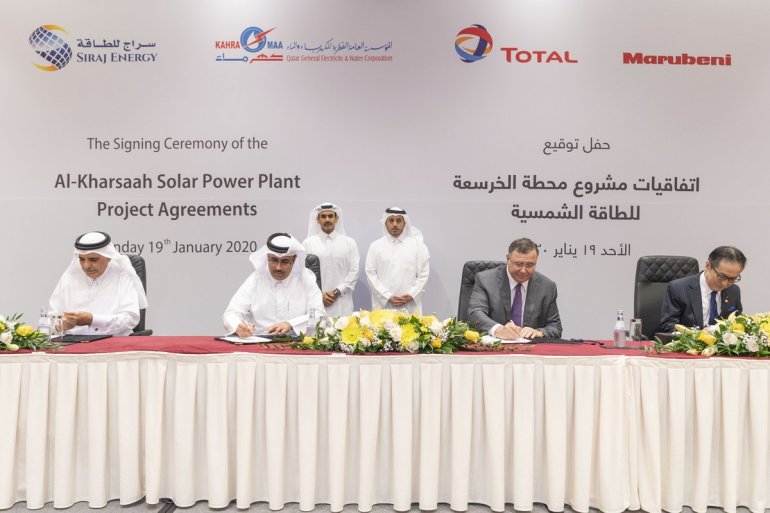
DOHA: Qatar has signed an agreement with France's Total and Japan's Marubeni to build a solar power project with capacity of about 800 megawatts (MW), which equals about 10% of Qatar’s current peak electricity demand.
The Prime Minister and Interior Minister H E Sheikh Abdullah bin Nasser bin Khalifa Al Thani and H E Saad Sherida Al-Kaabi, Minister of State for Energy Affairs and President and CEO of Qatar Petroleum, attended the signing ceremony to build Al Kharsaah Large-Scale Solar PV Power Plant and to establish the project company as well as for power purchase from the plant held at Doha Sheraton Hotel on Sunday.
The agreements were signed by Essa bin Hilal Al Kuwari, President of Kahramaa, Fahad bin Hamad Al Mohannadi, General Manager and Managing Director of Qatar Electricity and Water Company and member of the Board of Directors of Siraj Energy, Masumi Kakinoki, President and CEO of Marubeni Corporation, and Patrick Pouyanné, Chairman and Chief Executive Officer of Total.
With an estimated total cost of QR 1.7 billion ($467 million), the Large-Scale Solar PV Power Plant will be constructed at Al-Kharsaah area west of Doha on a 10 square kilometer land plot.
Qatar's Siraj Energy, a joint venture owned by Qatar Petroleum (QP) and Qatar Electricity and Water Company (QEWC), will hold a 60% stake in the solar plant. The remaining 40% will be owned by both Marubeni and Total.
Qatar General Electricity & Water Corporation (Kahramaa) in its capacity as the Transmission and Distribution System Owner and Operator (TDSOO) in Qatar will buy electricity from Siraj1. The project follows a Build, Own, Operate, and Transfer (BOOT) model and has a term of 25 years, after which the ownership will be transferred to Kahramaa.
"Today is the commencement of the project itself and we expect by the first quarter of 2021 to have half of the (plant's) capacity up and running," H E Al-Kaabi said, adding that the project will reach full capacity by the first quarter of 2022.
The minister said that Qatar, the world's largest supplier of liquefied natural gas (LNG), plans more solar projects as the country aims to reduce carbon emissions and minimise its impact on the environment.
“This project also comes as part of the energy sector’s contributions towards Qatar’s commitment to host the FIFA 2022 World Cup. It will generate about 8 times the size of the solar energy Qatar had pledged to build, helping the organization of a carbon neutral event,” H E Al Kaabi added.
In October Qatar had commissioned a carbon capture and storage plant and aims to sequester 5 million tonnes of carbon from its LNG operations by 2025.
“Monitoring the recent developments in solar panel manufacturing including their improving efficiency and decreasing costs, and considering the natural gas quantities that can potentially be saved and the associated emissions reductions, Kahramaa has decided to go forward with a utility-scale solar power plant,” Kahramaa President said.
“Kahramaa requested bids, attracted bidders, and completed the prequalification of 16 leading international Solar Power Developers, evaluated the technical and commercial offers, and succeeded in obtaining a competitive unit price for electricity produced from the Solar PV Power Plant, which is currently the lowest in the world for such a project,” Al Kuwari added.
“The project will include application of the latest solutions and innovations in solar energy technology, including use of dual panels, utilizing state-of-the-art automated systems to track the sun and the use of robots in the continuous cleaning of solar panels to ensure the continuity of production efficiency and reduce plant operating costs,” Al Mohannadi said.
The total capacity of Al-Kharsaah Solar PV Power Plant is 800 MW. During the first phase of the project, 350 MW will be connected to the grid by the first quarter of 2021 while the commercial commissioning of the total capacity is expected to start in the first quarter of 2022 in line with strategic objective set in Qatar National Development Strategy 2018 – 2022.
During the project’s lifetime, the plant will contribute to reducing 26 million tonnes of CO2, which aligns with the objectives of the national program for conservation and energy efficiency “Tarsheed” to reduce 1 million tonnes of carbon emissions annually until 2022.
